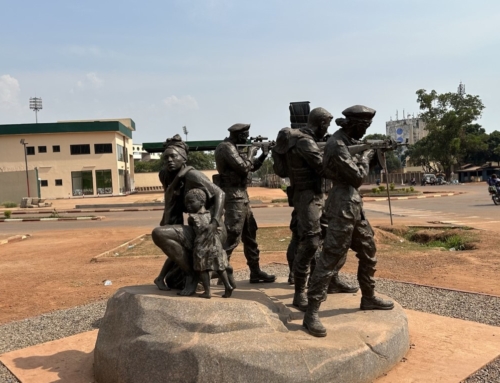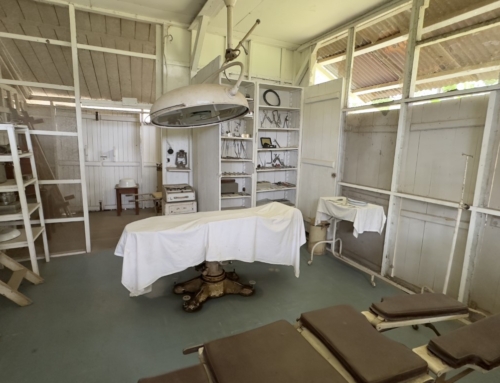Eritrean Train. Dots of coal soot polka-dotted my shirt. Droplets of water gently graced my face and arms like a rainbow butterfly-kissing a unicorn. The whistle shrieked and I temporarily covered my ears. My body pressed against the railing on the platform, and I marveled in the presence of the steam engine of the Eritrean railway.
The construction of the railway was a 45 year project until completely finished, starting in 1887. The line snaked 209 miles. The original line stretched from the port town of Massawa on the Red Sea to the heart of Eritrea in Bishia. Today the line has been truncated, it runs 73 miles from Massawa to the capital, Asmara. Eritrea was a former Italian colony, and this was a multi-year project overseen by the Kingdom of Italy.
This project was an engineering marvel for its times. The construction of this narrow gauge track (950 mm), which allowed for tighter turns, challenged the Italian engineers. Construction included 65 bridges and 39 tunnels, with one tunnel stretching over 1000 feet. As the track moves from the coast at sea level to the plateau of Asmara, it climbs to nearly 8,000 feet. The grades were over 3% which were challenging for early 20th century.
In 1935, it was used extensively for the Mussolini’s war efforts in conquering Eritrea’s neighbor, Ethiopia. Tens of thousands of Italian soldiers rode these rails to the front.
For a ferroequinologist, riding these rails epitomize a superlative train experience. The carriage was being pulled by a 1930’s vintage Mallet locomotive. A plate detailed the lineage of the engine … 1938 in Genova. The carriage dated to 1912 and traced its history to Milan.

Our group, numbering 20 was extremely fortunate to board the one forest-green, passenger car attached the engine. Like monkeys on a jungle gym, we rushed into the car exploring all nooks and crannies, snapping pictures and exchanging mile-wide grins. The group settled into the wooden benches. We had chartered the train for the day and were about to explore the mountainous track. Tourists rarely venture to the closed-off Eritrea. This train is chartered approximately only ten times a year.
The engineers shoveled coal into the engine. Grey steam protruded from the engine room and the whistle screamed to announce our departure. I stood on the platform next to the brakeman, who was manually operating the brakes of the passenger car.
The train puffed and strained up steep mountains. The Serpente d’acciaio (steel snake) balanced over tight-rope lengths of strips of land. I peered down, and stared into a deep abyss of green and tan land. It would be a long plummet if the train slid off from its rails. We passed dozens and dozens of children who chased after us, sometimes keeping pace with the meandering train. Viewing the train by their homes was a pleasant surprise since it made infrequent appearances. We passed women lugging buckets of water. We spotted hovel-like tents housing conscripted soldiers. Goats, camels, and a lone donkey signaled hello as we passed the incredibly gorgeous landscape. Cactus reached out to poke the nearby carriage, sometimes reaching into the open windows.


After several hours we were returned back to the train station in Asmara, wishing for more. But ecstatic for the experience. Eritrean Train. to learn more about Eritrea, check this out.
Learn more about visiting Massawa and the faces of Eritrea.

Photos From Chernobyl
Sign up to receive your free copy of Photos From Chernobyl. Over 100 photos from the Chernobyl Exclusion Zone.


















[…] Massawa, Eritrea. If you want to learn more about Eritrea, check out this story about the Eritrean Train and the beautiful faces of Eritrea. Eritrea is a seldomly visited but is full of […]
[…] you want to learn about Africa’s most awesome train experience, or the beautiful faces of […]
[…] Read about the amazing train ride in Eritrea! […]
[…] we were not done yet. The brains behind the Young Pioneers had one more surprise in store for us: a historic train ride. Through a 40-year effort the Italians constructed an amazing rail line from the coast in Massawa, […]
[…] Read about the amazing train ride in Eritrea! […]
[…] My group piled into the lone passenger car and readied ourselves onto the wooden benches. The train puffed through the countryside, gliding through small villages and traversing bridges. Animated […]
[…] Eritrean Train […]
[…] you want to learn about Africa’s most awesome train experience or the beautiful faces of […]